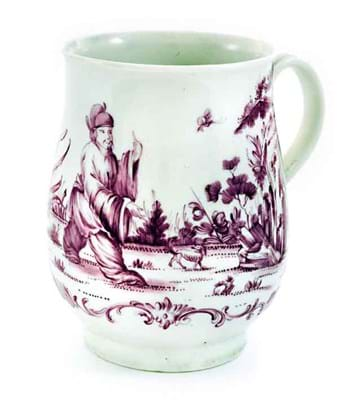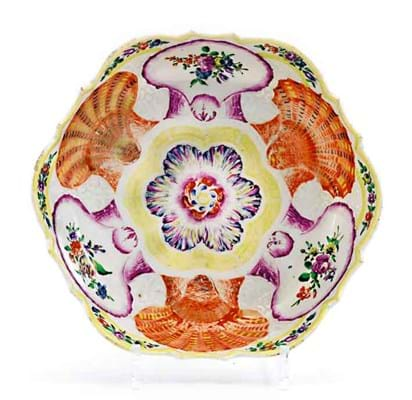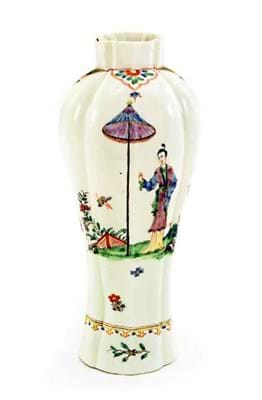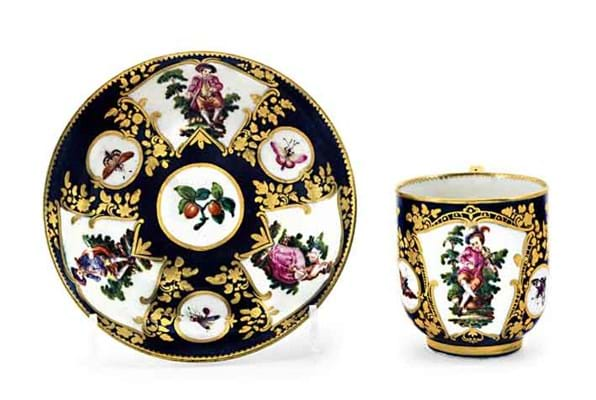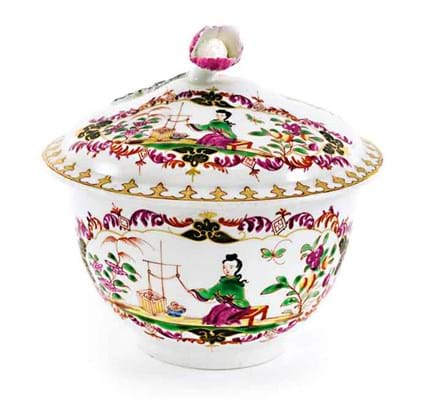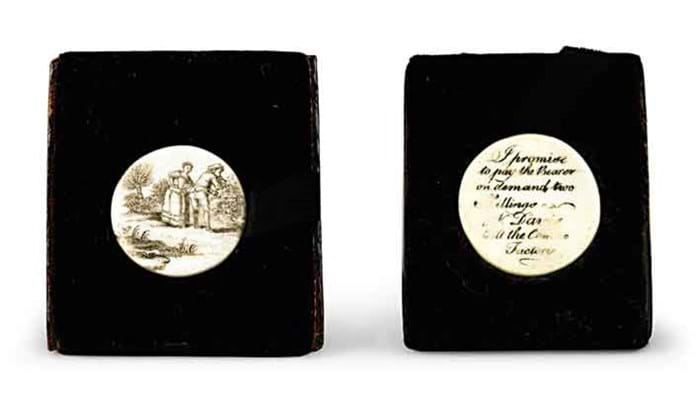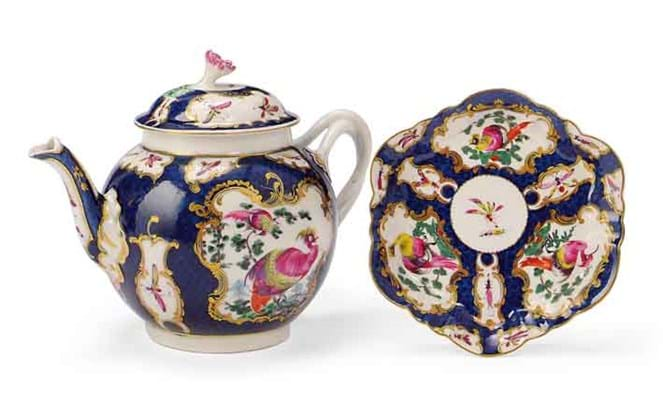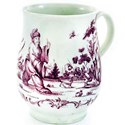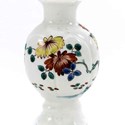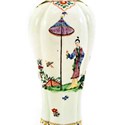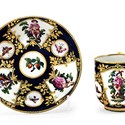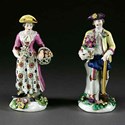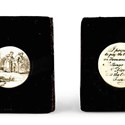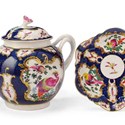The two often hunted their ceramic quarry together, sometimes splitting pairs.
Guided by the well-known dealers the Tilleys, Grant Dixon refined his holdings to create an attractive and balanced collection which, on his death in 1971, he bequeathed to Ampleforth Abbey, Yorkshire to help one of its number, Father James Forbes, further his studies on 18th century porcelain.
The Benedictine monastery deemed it unsuitable for an institution dedicated to religion, education and the simple life, so instead the collection was sent by Father James to the Ashmolean - only to be returned to Ampleforth in 1989. The trustees recently made the decision to sell it at auction.
These days Bonhams Bond Street has become the first port of call for single-owner sales of 18th century English porcelain in general and first period Worcester in particular (the Zorenksy, Sir Jeremy Lever and David Butti auctions being amongst the most recent). Indeed, this week sees Bonhams holding their spring auction of British ceramics, an event that includes two single-owner collections of Lowestoft, one belonging to Geoffrey Godden.
However, collections do turn up in the other London rooms and this time it was Sotheby's (25/20/12% buyer's premium) who were entrusted with the Grant Dixon Worcester collection.
But, despite being fresh to the market and with a good provenance, the collection which ran to just 80 lots was too small for a stand-alone sale. Instead it featured as the central section of a 482-lot auction at Sotheby's Bond Street on April 13 that also took in furniture, works of art, silver and clocks - the type of large, mixed-discipline auction that is increasingly used by Sotheby's and Christie's as a selling format.
Given that nothing in the Grant Dixon sale had been acquired more recently than 1970, this 80-lot collection was surprisingly not 'old school' taste. True there were some of the later coloured ground pieces from the 1770s that no longer chime with collectors quite as they did a couple of decades ago, but there were also plenty of the currently fashionable simple famille rose and kakiemon-decorated wares and a good slice of popular outside-decorated material from the Giles Workshop.
These features, plus the good overall condition, all stood in the collection's favour. Less so, perhaps, is the current market with demand less robust than it was a few years ago.
This is something which auctioneers have to micro-manage when assessing values and pitching reserves. Sotheby's usually have a £3000 minimum lot value but in a field like English porcelain this can be steep even for good pieces. Fortunately their specialist Philip Howell was given some flexibility on this occasion.
Around 30 individual pieces carried guides under that level and other items of more modest individual value were offered as group lots to bump up their value.
Even so, some of the guides proved too steep for current tastes - 23 lots were left unsold although Mr Howell said that a high proportion found buyers post sale - but then this was an erratic results sheet with some pieces making very high prices and others performing rather below par.
Opening lot
Perhaps the best illustration of this was the sale's opening lot. This was a very rare and early documentary piece, a 4½in (11.5cm) high bell-shaped mug inscribed EL 1754 which was formerly in the Dr H.E. Rhodes Collection, had been published in the ECC transactions and exhibited in 1981 by Albert Amor in their exhibition: Worcester Porcelain the first Decade 1751-1761.
Two similar dated mugs with the same decoration have passed through Sotheby's but that was back in 1965 and 1972 and they are now in the V&A and Colonial Williamsburg. The most recent comparison we have are two undated waisted cylindrical vases bearing the same decoration that were sold from the Jeremy Lever and Paul Crane collections in 2007 and 2010 for £13,000 and £8000 respectively.
On this basis Sotheby's £10,000-15,000 estimate on the Grant Dixon version was not unreasonable. Yet it failed to find a buyer.
Similarly, two other bell-shaped mugs got away more cheaply than predicted. One was the very early 3½in (9.5cm) high creamy paste example of c.1752-3 painted in delicate shades with a Long Eliza Chinese figure by a balustrade with a sailing ship to the reverse. Estimated at a bullish £10,000-15,000, it got away at £8000.
The other was slightly later at c.1758 (five years are key during these early production years) and around an inch taller. Its main attraction was the finely painted decoration in a lilac/ purple camaieu of a Chinese man with a small dog walking in a garden underlined with rococo scrolls.
Grant Dixon had acquired this in 1967 for the then substantial sum of £550. This time it came with a guide of £5000-8000 but ended up going for £4500.
Contrast the prices for the mugs with the very substantial £14,000 paid for a tiny 3¼in (8.5cm) high baluster vase of c.1754 painted in kakiemon style with a ho-ho bird on rocks. It was a very rare shape and the kakiemon decoration, while not as unusual, is highly desirable, but this was still a substantial sum.
Equally, the £8500 paid for a 9½in (24cm) diameter yellow ground junket dish from 1770s seemed very bullish for a less than fashionable class of Worcester. The brilliant rainbow of coloured enamels used for the scallop shell and flowerhead decoration were unusual so perhaps that is why bidders pursued it to more than double the estimate.
The top lot in the sale was another early piece decorated in the famille rose palette with a Long Eliza figure, a 7½in (19cm) high vase of slender baluster form c.1754-55 which realised £20,000, double the pre-sale guide.
Scale blue ground Worcester, while not from the earliest production period, has some keen adherents, as do the sought-after pieces decorated in the James Giles workshop. When the two elements are combined appeal increases as in the cases of a 1770s, 10½in (26cm) wide heart-shaped dish of Lady Mary Wortley type finely painted with Giles's 'fancy birds'
that realised £4500; or a powder blue ground coffee cup and saucer from the Lord Dudley service c.1765-68, painted in the Giles studio with European musicians and female dancers, butterflies and gilt flowersprays at £5500. A single 7½in (19cm) diameter Giles plate decorated with his fancy birds and butterflies on a white ground was also pursued to a very substantial £3800.
Rare figures
Worcester figures are much rarer than tablewares and the Grant Dixon collection offered two pairs, both dating from c.1770: a 6½in (16.5cm) high gardener and companion and a 5in (13cm) high Turk and companion.
The nearest saleroom comparisons come from the Zorenksy collection sold across three auctions at Bonhams from 2004 to 2006. There a white pair of gardeners took £14,000 and a single coloured gardener figure with a bocage £8200.
The Zorenskys also owned two pairs of Turks, one with paler toned costume sold for £4800, the other with brighter clothing at £8200. For the Grant Dixon sale the gardening group (the man with a restored hat and spade), came in at £15,000 but the Turks, guided at £6000- 8000, failed to get away.
Meanwhile, Christie's South Kensington's (25/20/12% buyer's premium) Interiors auction on May 10 offered the opportunity to acquire two 1768 Worcester blue ground teapots on stands with decoration of birds and flowers not dissimilar to that seen on some of the Grant Dixon lots offered at Sotheby's the month before.
Both were in good overall condition with only minor chips to the extremities and wear to the stands, although one teapot cover had a crack to the flange. Offered with guides of £1000-1500, they sold for £1100 and £1000.

